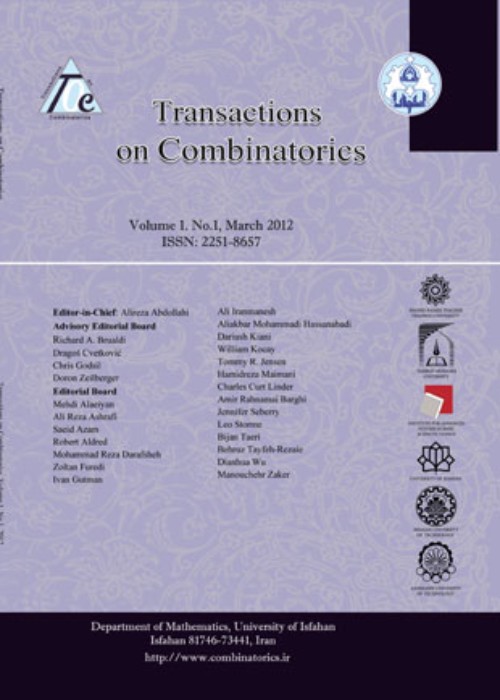فهرست مطالب

Transactions on Combinatorics
Volume:13 Issue: 1, Mar 2024
- تاریخ انتشار: 1402/12/11
- تعداد عناوین: 7
-
-
Pages 1-16In 2021, Gutman invented a novel degree-based topological index called the Sombor index, inspired by a geometric interpretation of degree-radii of the edges and invited researchers to investigate their mathematical properties and chemical meanings. The Sombor index was reformulated in terms of the edge degree instead of the vertex degree as the original Sombor Index. In this paper, we compute the exact values of a certain class of graphs. Also, some bounds in terms of the order, size, minimum/maximum degrees and other topological indices are obtained.Keywords: Reformulated Zagreb indices, Sombor Index, Reformulated Sombor Index
-
Pages 17-30Let $\mathtt{A}(\mathtt{G})$ be the adjacency matrix of a simple connected undirected graph $\mathtt{G}$. A graph $\mathtt{G}$ of order $n$ is said to be non-singular (respectively singular) if $\mathtt{A}(\mathtt{G})$ is non-singular (respectively singular). The spectrum of a graph $\mathtt{G}$ is the set of all its eigenvalues denoted by $spec(\mathtt{G})$. The anti-reciprocal (respectively reciprocal) eigenvalue property for a graph $\mathtt{G}$ can be defined as `` Let $\mathtt{G}$ be a non-singular graph $\mathtt{G}$ if the negative reciprocal (respectively positive reciprocal) of each eigenvalue is likewise an eigenvalue of $\mathtt{G}$, then $\mathtt{G}$ has anti-reciprocal (respectively reciprocal) eigenvalue property ." Furthermore, a graph $\mathtt{G}$ is said to have strong anti-reciprocal eigenvalue property (resp. strong reciprocal eigenvalue property) if the eigenvalues and their negative (resp. positive) reciprocals are of same multiplicities. In this article, graphs satisfying anti-reciprocal eigenvalue (or property $(-\mathtt{R})$) and strong anti-reciprocal eigenvalue property (or property $(-\mathtt{SR})$) are discussed.Keywords: Anti-reciprocal eigenvalue property, strong anti-reciprocal eigenvalue property, Adjacency Matrix, graph spectrum
-
Pages 31-40In this paper, we give a method for the constructions of Hadamard matrices of composite orders by using suitable $T$-matrices and known Hadamard matrices. We establish a formula for $T$-matrices and Hadamard matrices and discuss under what condition we can get $T$-matrices from the known Hadamard matrices.Keywords: Composite Hadamard matrix, $T$-matrix, Hadamard matrix, Suitable matrices
-
Pages 41-66Motivated to find the answers to some of the questions that have occurred in recent papers dealing with Hamiltonian cycles (abbreviated HCs) in some special classes of grid graphs we started the investigation of spanning unions of cycles, the so-called 2-factors, in these graphs (as a generalizations of HCs). For all the three types of graphs from the title and for any integer $m \geq 2$ we propose an algorithm for obtaining a specially designed (transfer) digraph ${\cal D}^*_m$. The problem of enumeration of 2-factors is reduced to the problem of enumerating oriented walks in this digraph. Computational results we gathered for $m \leq 17$ reveal some interesting properties both for the digraphs ${\cal D}^*_m$ and for the sequences of numbers of 2-factors.We prove some of them for arbitrary $m \geq 2$.Keywords: Hamiltonian cycles, generating functions, transfer matrix method, 2-factor
-
Pages 67-84We obtain the generating function for the number of columns of fixed height $r$ in a bargraph (classified according to semi-perimeter). As initial case for two distinct methods we first find the generating function for columns of height $1$. Then using a first-return-to-level-$1$ decomposition, we obtain the rational function version of the continued fraction generating function which allows us to derive separate recursions for its numerator and denominator. This then allows us to get the asymptotic average number of columns for each $r$. We also obtain an equivalent generating function by exploiting a sequential decomposition for bargraphs in terms of columns of height $r$.Keywords: generating function, bargraphs, column height
-
Pages 85-103In this paper, we put forward the idea of variable sum exdeg energy of graphs. We study the algebraic properties of variable sum exdeg energy. Some properties related to spectral radius of variable sum exdeg matrix are determined. We determine some Nordhaus-Gaddum-type results for variable sum exdeg spectral radius and energy. Some classes of variable sum exdeg equienergetic graphs are also determined.Keywords: Variable sum exdeg energy, Variable sum exdeg spread of graphs, Nordhaus-Gaddum-type results
-
Pages 105-126A broadcast on a nontrivial connected graph $G=(V,E)$ is a function $f:V\rightarrow\{0, 1,\dots,d\}$, where $d=\operatorname{diam}(G)$, such that $f(v)\leq e(v)$ (the eccentricity of $v$) for all $v\in V$. The weight of $f$ is $\sigma(f)={\textstyle\sum_{v\in V}} f(v)$. A vertex $u$ hears $f$ from $v$ if $f(v)>0$ and $d(u,v)\leq f(v)$. A broadcast $f$ is dominating if every vertex of $G$ hears $f$. The upper broadcast domination number of $G$ is $\Gamma_{b}(G)=\max\left\{ \sigma(f):f\text{ is a minimal dominating broadcast of }G\right\}.$ A broadcast $f$ is boundary independent if, for any vertex $w$ that hears $f$ from vertices $v_{1},\ldots,v_{k},\ k\geq2$, the distance $d(w,v_{i})=f(v_{i})$ for each $i$. The maximum weight of a boundary independent broadcast is the boundary independence broadcast number $\alpha_{\operatorname{bn}}(G)$. We compare $\alpha_{\operatorname{bn}}$ to $\Gamma_{b}$, showing that neither is an upper bound for the other. We show that the differences $\Gamma _{b}-\alpha_{\operatorname{bn}}$ and $\alpha_{\operatorname{bn}}-\Gamma_{b}$ are unbounded, the ratio $\alpha_{\operatorname{bn}}/\Gamma_{b}$ is bounded for all graphs, and $\Gamma_{b}/\alpha_{\operatorname{bn}}$ is bounded for bipartite graphs but unbounded in general.Keywords: broadcast domination, broadcast independence, hearing independent broadcast, boundary independent broadcast

